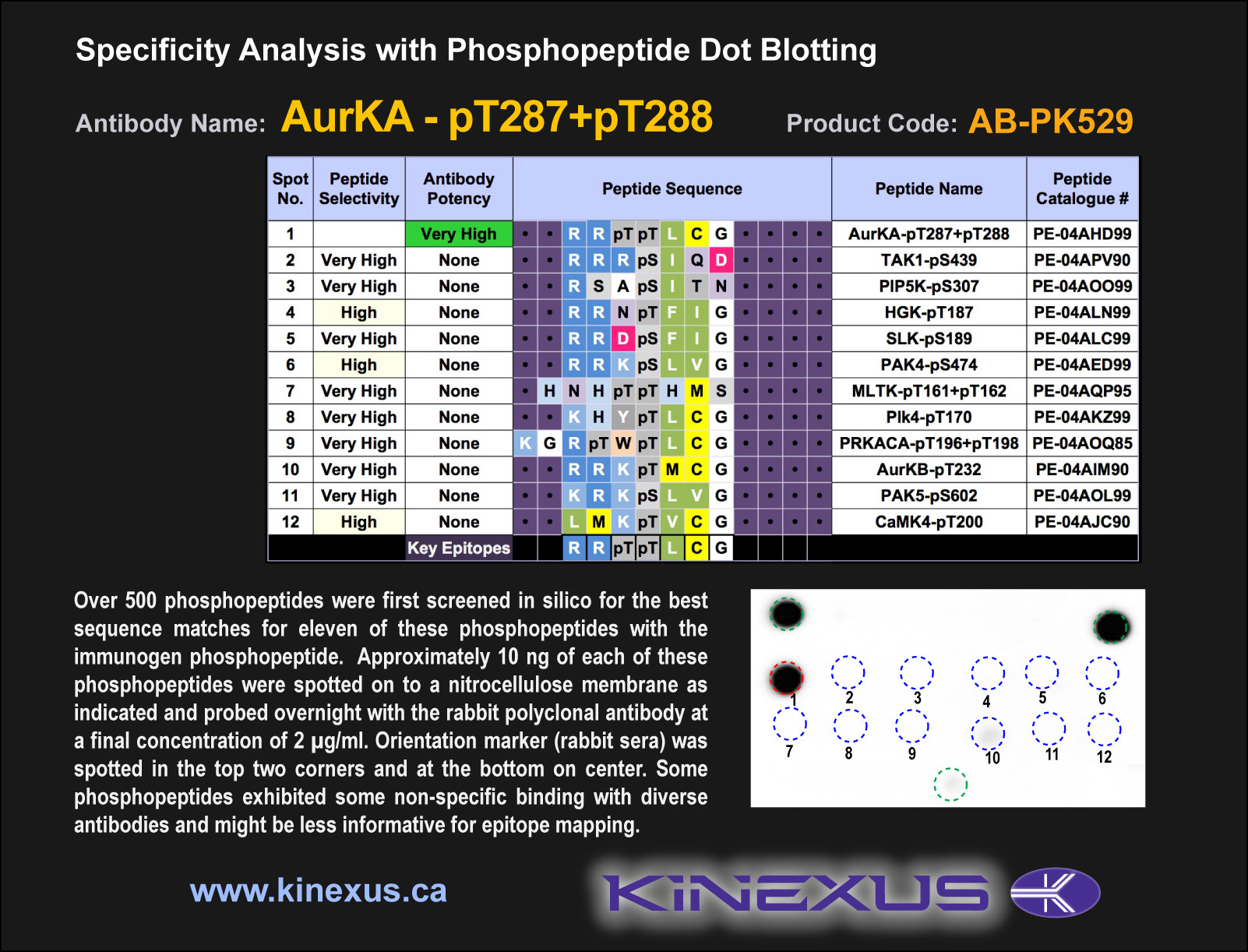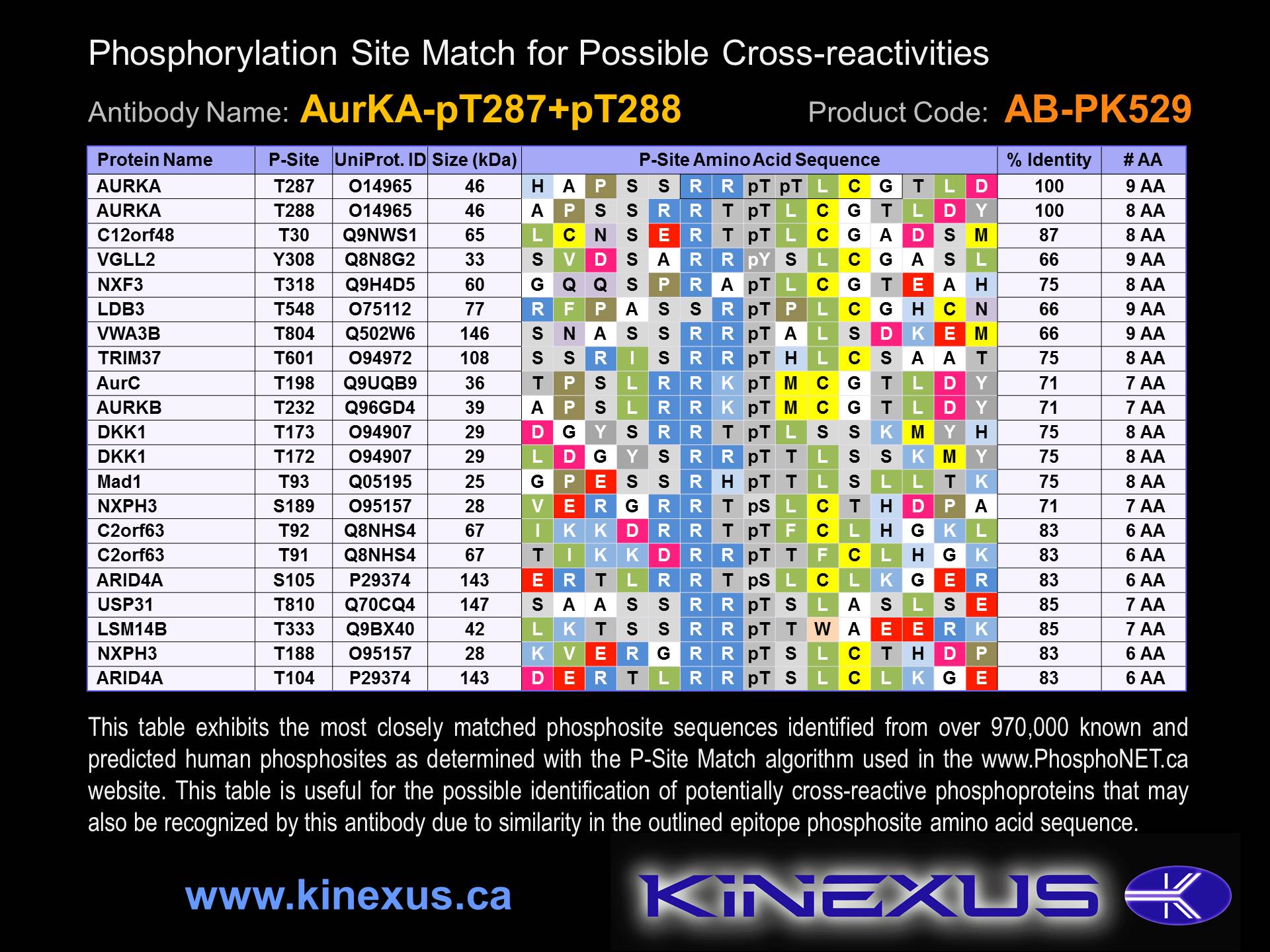Product Name: AurKA-pT287+pT288
Product Number: AB-PK529
| Size: | 25 µg | Price: | 89.00 | |
| $US |
Target Full Name: Aurora Kinase A (serine/threonine protein kinase 6)
Target Alias: AIK; ARK1; AurkA; Aurora kinase A; Aurora,IPL1-related kinase 1; Aurora/IPL1-related kinase 1; Aurora-1; Aurora-A; Aurora-family kinase 1; STK7; BTAK; STK15; STK6; AURORA2; AurA; MGC34538; CCDS13451.1; ENSG00000087586
Product Type Specific: Protein kinase phosphosite-specific antibody
Antibody Code: PK529
Antibody Target Type: Phosphosite-specific
Antibody Phosphosite: T287+T288
Protein UniProt: O14965
Protein SigNET: O14965
Antibody Type: Polyclonal
Antibody Host Species: Rabbit
Target Alias: AIK; ARK1; AurkA; Aurora kinase A; Aurora,IPL1-related kinase 1; Aurora/IPL1-related kinase 1; Aurora-1; Aurora-A; Aurora-family kinase 1; STK7; BTAK; STK15; STK6; AURORA2; AurA; MGC34538; CCDS13451.1; ENSG00000087586
Product Type Specific: Protein kinase phosphosite-specific antibody
Antibody Code: PK529
Antibody Target Type: Phosphosite-specific
Antibody Phosphosite: T287+T288
Protein UniProt: O14965
Protein SigNET: O14965
Antibody Type: Polyclonal
Antibody Host Species: Rabbit
Antibody Immunogen Source: Human AurKA (Aurora A, AIK, STK15) sequence peptide Cat. No.: PE-04AHD99
Antibody Immunogen Sequence: RR(pT)(pT)LCG(bA)C
Antibody Immunogen Description: Corresponds to amino acid residues R285 to G291; In the protein kinase catalytic domain activation T loop region between subdomains VII and VIII.
Antibody Immunogen Sequence: RR(pT)(pT)LCG(bA)C
Antibody Immunogen Description: Corresponds to amino acid residues R285 to G291; In the protein kinase catalytic domain activation T loop region between subdomains VII and VIII.
Production Method: The immunizing peptide was produced by solid phase synthesis on a multipep peptide synthesizer and purified by reverse-phase hplc chromatography. Purity was assessed by analytical hplc and the amino acid sequence confirmed by mass spectrometry analysis. This peptide was coupled to KLH prior to immunization into rabbits. New Zealand White rabbits were subcutaneously injected with KLH-coupled immunizing peptide every 4 weeks for 4 months. The sera from these animals was applied onto an agarose column to which the immunogen peptide was thio-linked. Antibody was eluted from the column with 0.1 M glycine, pH 2.5. Subsequently, the antibody solution was neutralized to pH 7.0 with saturated Tris.This antibody was also subject to negative purification over phosphotyrosine-agarose.
Antibody Modification: Unconjugated. Contact KInexus if you are interest in having the antibody biotinylated or coupled with fluorescent dyes.
Antibody Modification: Unconjugated. Contact KInexus if you are interest in having the antibody biotinylated or coupled with fluorescent dyes.
Antibody Concentration: 1 mg/ml
Storage Buffer: Phosphate buffered saline pH 7.4, 0.05% Thimerasol
Storage Conditions: For long term storage, keep frozen at -40°C or lower. Stock solution can be kept at +4°C for more than 3 months. Avoid repeated freeze-thaw cycles.
Product Use: Western blotting | Antibody microarray
Antibody Dilution Recommended: 2 µg/ml for immunoblotting
Antibody Species Reactivity: Human
Antibody Positive Control: The observed molecular mass of the processed target protein on SDS-PAGE gels is reported to be around 45-50 kDa.
Antibody Specificity: Very high
Storage Buffer: Phosphate buffered saline pH 7.4, 0.05% Thimerasol
Storage Conditions: For long term storage, keep frozen at -40°C or lower. Stock solution can be kept at +4°C for more than 3 months. Avoid repeated freeze-thaw cycles.
Product Use: Western blotting | Antibody microarray
Antibody Dilution Recommended: 2 µg/ml for immunoblotting
Antibody Species Reactivity: Human
Antibody Positive Control: The observed molecular mass of the processed target protein on SDS-PAGE gels is reported to be around 45-50 kDa.
Antibody Specificity: Very high
Antibody Cross Reactivity: No immunoreactivity on protein dot blots with recombinant human AurKB or AurKC. No cross-reactive proteins detected in sea star oocytes.
Related Product 1: AurKA-pT287+pT288 blocking peptide
Related Product 2: AurKA pan-specific antibody (Cat. No.: AB-NK008-3P)
Related Product 3: AurKA pan-specific antibody (Cat. No.: AB-NK008-4P)
Related Product 4: AurKA-1 pan-specific antibody (Cat. No.: AB-NK008-3)
Related Product 5: AurKA-2 pan-specific antibody (Cat. No.: AB-NK008-4)
Related Product 6: AurKA-3 pan-specific antibody (Cat. No.: AB-NK008-5)
Related Product 1: AurKA-pT287+pT288 blocking peptide
Related Product 2: AurKA pan-specific antibody (Cat. No.: AB-NK008-3P)
Related Product 3: AurKA pan-specific antibody (Cat. No.: AB-NK008-4P)
Related Product 4: AurKA-1 pan-specific antibody (Cat. No.: AB-NK008-3)
Related Product 5: AurKA-2 pan-specific antibody (Cat. No.: AB-NK008-4)
Related Product 6: AurKA-3 pan-specific antibody (Cat. No.: AB-NK008-5)
Scientific Background: AurA (AurKA, AIK) is a protein-serine/threonine kinase of the Other group and AUR family. It regulates cell cycle progression, and it mediates chromosomal segregation during mitosis. AurA phosphotransferase activity is greatest during mitosis. It is activated by phosphorylation at S284, T287, T288 and S342. AurA appears to be a tumour requiring protein (TRP). The active form of the protein kinase normally acts to promote tumour cell proliferation. Although AurA is not an oncoprotein, it is required for upstream oncoproteins to promote tumour formation. Its low rate of mutation and down-regulation in human cancers supports it identification as a TRP, and as a target for cancer drug development. However, the overexpression of AURA has been well documented in many malignant cancers including breast, ovarian, colon, prostate and neuroblastomas. Overexpression of AURA appears to override checkpoints in cell cycle progression leading to increased cell division and proliferation. Its phosphotransferase activity is decreased 10-fold with G198N (which also induces abnormal binding to INCENP and BIRC5), or increased with T288D. Phosphatase type I interactions could be decreased with F165A, and F346A mutations, while ubiquitination could be reduced with R205A. Autophosphorylation is inhibited with D274N, and TPX2 interactions are interrupted with a T287E mutation.
Figure 1. Epitope mapping of AurKA-pT287+pT288 antibody with similar phosphopeptides on dot blots.
Figure 2. Identification of phosphosites related to AurKA-pT287+pT288.
© Kinexus Bioinformatics Corporation 2017



